- About Us
- Columns
- Letters
- Cartoons
- The Udder Limits
- Archives
- Ezy Reading Archive
- 2024 Cud Archives
- 2023 Cud Archives
- 2022 Cud Archives
- 2021 Cud Archives
- 2020 Cud Archives
- 2015-2019
- 2010-2014
- 2004-2009
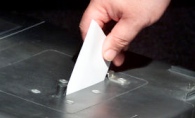 |
22nd August 2010, post Election Day |
Where there is no vision, the people perish. Proverbs 29:18
The biblical quote is only a slight exaggeration. Australia is divided and confused to the extent that it was unable to decisively elect a leader or leading party. At the end of counting on election night, Australia’s Parliament was hung more heavily than a pair of Abbott Speedos.
Whoever wins the Australian Election for 2010, the Australian public are faced with a Government that could be unstable and may not last a full term. It is near to an indictment on both leaders of the major parties that neither was able to cut through with voters and deliver their messages simply and clearly. As incumbents, perhaps most of the criticism needs to be levelled at the Labor Party. Over 9 months they squandered an almost unbeatable lead in the polls, sinking from record highs to election-losing lows. Most of it was self inflicted; and a generous portion was at the hands of opposition leader Tony Abbott. However, most of the latter was just because he (Abbott) was there. Luckily, the democratic safety net was in place and the electoral gaps were plugged with the fluid flow of green preferences and Independent MPs – regardless of how successful this will be in the long term.
There are cases where a cooperative Government has ‘worked’ – for example Sweden’s consensus building system between Government, industry, trade unions and the community, has put this small nation in front of the pack in many areas. However, the obvious risk is that the lack of a decisive, definitive Government will leave Australia in a policy freeze – though perhaps even that is nothing extreme compared with the last year in Australian politics.
This essay, Part 1 of 2, plots the course of the lead up to this predicament, with a healthy coverage of the intrigue and the sidebars, and tries to pinpoint why the election resulted in a hung parliament. While the last political piece from this correspondenti focussed on the Liberal Party, this one evens the ledger. Part 2 extricates the story from the trivial to cover the policies of the new Government, when it is finally elected, and what we can expect in the years ahead.
The election lead-up
The Game changer….
In December 2009 Tony Abbott beat Malcolm Turnbull by one vote in a leadership spill that was triggered by infighting over the Opposition stance on an emissions trading scheme (ETS) in Australia. Abbott’s calculation was that the Liberals should change their policy position away from an ETS, a polar position to Turnbull’s. Abbott’s subsequent seizure of the Liberal leadership was the circuit breaker in Rudd’s hitherto unchallenged run in the polls. Abbott’s “oppose at all costs” modus operandi, supported by the rogue and at times foul-mouthed Barnaby Joyce, was otherwise unconstructive save for its brutal effectiveness in frustrating and ultimately dismantling Rudd.
After the Opposition leadership win, Abbott commenced to prosecute a fairly simple and direct campaign that effectively exploited Rudd’s policy weaknesses. Typically, Rudd’s signature policy was something complex with a snappy-sounding acronym name (CPRS, RET, RSPT), yet which was difficult to explain and was thus poorly communicated. This left a policy such as the CPRS/ETS vulnerable to being smashed by someone with a penchant for the one liner, such as Abbott. His “great big taxes” or “another new tax” lines, and Joyce’s ETS = “Employment Termination Scheme” immediately struck resounding notes across Australia. Regardless of whether they were telling the truth, at least people understood the message.
1st mistake
Rudd had pushed the case for early action on climate change since 2007. It was his election-winning mandate and it had been used by Labor throughout 2009 to wedge the Opposition, flaying Brendon Nelson early and keeping his successor Turnbull on the ropesii. The climate change wedge was taken a step further, in arguing that Australia should lead the world on climate change – manifested by an ETS agreed and legislated in Australia prior to an important meeting of world leaders on climate change in Copenhagen in December 2009. This was not achieved and the Copenhagen meeting itself showed that the world and indeed Australia was not ready for a comprehensive agreement on climate change policy. This failure and some very ugly press about the climate change movementiii took the wind out of the sails of the momentum towards climate change policy. Rudd was left high and dry with his CPRS, a well-intentioned but politically unwieldy and complex beast that had enraged industry and Greenies alike.
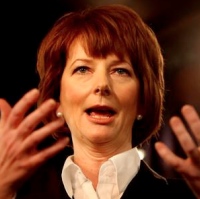 By early 2010, Rudd’s relentless focus groups and community polling had picked up a shift in sentiment away from climate change action, and the policy itself had been put down in Parliament twice.
By early 2010, Rudd’s relentless focus groups and community polling had picked up a shift in sentiment away from climate change action, and the policy itself had been put down in Parliament twice.
Thinking he was cutting his losses, Rudd abandoned the ETS in April 2010, coming around to a similar assessment as Abbott that the tides had changed away from climate change policy in the Australian public. This was classic Rudd, a prisoner to the polls and the 24 hour media cycle, perhaps when he should have been sticking to his guns and showing true leadership on a potentially dire social and environmental issue. Although Labor may have made a political mistake with a “go hard, go early” position on climate change for Australia, the back flip was disastrous and half of Australia immediately felt they had a weak Prime Minister. The poll effects were instant, with a crash in support for Labor. Abbott seized the initiative and rolled out his own ‘direct action’ climate change policy which, although half baked and fanciful, was at least simple and easy enough to understand.
At the same time, Rudd had notched up a major policy back flip.
RSPT: find out what it means to me
The roll out of the Resources Super Profits Tax (RSPT) proposal was engineered to make Rudd appear strong after the ETS back flip. It was all about perception correction.
The basic concepts underlying the RSPT, namely a nationally-consistent tax on mining company profits, had some merit and were carefully laid out in the Henry Tax Review. However, the usual protocols of formal consultation, design and careful pitching to industry, were not followed.
Instead, the announcement had all the elements of political capital raising. Taxing the big end of town to fund reduced company tax and increased super contributions was supposed to impress small businesses and employees alike, and make the policy sponsors look big. The shock and awe delivery of the RSPT, with a “make them pay their fair share” mantra, was initially successful in its objective of wrong footing the mining industry. The latter were virtually bulldozed by Wayne Swan throughout May. Yet in the emergent battle of the messages the mining companies cut through much louder and with greater precision than the Government. The big mining houses are slow to rouse, but much like a B-Double on the highway once it has enough speed it is difficult to slow. Hundreds of millions of dollars were funnelled into a ruthless advertising campaign that included clever television, radio and press (full page AFR, the Australian and tabloid) advertisements. The Government’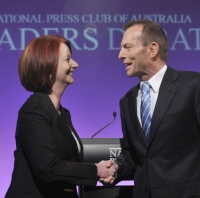 s own message was drowned out by the steady procession of massive mining projects called off, workers being laid off and mining company share prices plummeting, all in the wake of the RSPT announcement. The imagery of mining billionaires Andrew Forrest and Gina Reinhardt on the back of a Ute rallying a miner’s protest in Perth was laughable, yet somehow worked.
s own message was drowned out by the steady procession of massive mining projects called off, workers being laid off and mining company share prices plummeting, all in the wake of the RSPT announcement. The imagery of mining billionaires Andrew Forrest and Gina Reinhardt on the back of a Ute rallying a miner’s protest in Perth was laughable, yet somehow worked.
The RSPT strategy backfired to such an extent that the only way out for Rudd was another back flip. In July, Rudd’s strategists were devising a policy back flip that would somehow look courageous. However, by then the knives for Rudd were already being sharpened by the Labor factions, the faceless ‘machine men’ written about by former Labor leader Mark Latham in his memoirs. The dark shadowy figures responsible for his own political downfall.
The rolling of Rudd
In addition to the policy issues described above, all was not well in the Rudd backyard. Rudd came to power with little in the way of factional support or popular backing within the Labor Party. A loner, he was one of the few who stepped forward to wrest control of the party from Kim Beazley in December 2006.
Rudd was at his baby-cuddling, grandma-kissing and shopping centre-hopping best during the election campaign in 2007. It was the Rudd dream team, rock stars and TV presenters, catchy slogans, ‘Kevin07’ t-shirts, kicking Prime Ministers out of their own seats - the Rudd glory years rolled into a month.
Rudd delivered Labor the election win and for that the Labor faithful were grateful. But they never loved him. His leadership style was autocratic, he surrounded himself with an inner sanctum of bright young men who effectively ran the Government machine, and Cabinet consisted of a “Kitchen Cabinet” of Julia Gillard, Wayne Swan, Lindsay Tanner and of course Rudd. Policy directives were formulated from the sanctum and agreed with the Kitchen Cabinet. The wider Cabinet was not consulted, dissenters were bullied and resistance was quashed. There was grumbling and growing discontent throughout the Party.
Fine when the polls are going well, but in tough times there would be little between Rudd and the abyss.
Tough times indeed came for Rudd and the end was swift and brutal. On the night of 23rd June 2010, triggered by a final act of political faux pas by one of Rudd’s staffers, a lynch mob including then Deputy PM Julia Gillard and Defence Minister John Faulkner converged on Rudd’s office. The intention was to precipitate an immediate leadership spill. What was said between those four walls, we will not know until memoirs of the respective attendees are released. Promises may have been made and broken. Regardless, the next morning Rudd stood down from the Prime Ministership.
The deposition of Rudd was devised with the belief that putting a new face in front of the Australian public would be enough to restore the Labor vote. Labor had its new leader, but questions were immediately being asked about the way Rudd was knocked off. Many were unhappy with Rudd, but it is not the Australian way to stab your mate in the back as it was perceived, and the Gillard strategists failed to understand how this could permeate the Australian psyche and fester in the electorates. Although the love affair with Rudd had ended and Australia didn’t know who they had voted for – they certainly had not voted for Julia Gillard. Rudd may have been able to relight the fire and restore the love with the Australian people; however it is unknown whether this would have been possible. The Labor apparatchiks obviously felt it wasn’t and that the Gillard play was the less risky (although still dangerous) option.
Once deposed, Rudd himself didn’t help matters, staring ashen-faced from the backbench out to the Parliamentary cameras. Rudd then went into hospital to have his gall bladder removed. Many were shocked to hear that all he received from Gillard was a text message, on the same weekend she spent six hours on a photo shoot/interview with Women’s Weekly. Australians don’t like hearing these sorts of stories.
Sensing a serious mistake had been made, Julia Gillard quickly ran to the Rudd hospital bedside, and shortly after rolled out a ghostly white, sickly looking ex PM in front of the cameras on a Saturday morning in a fake, barely believable show of unity. It was another exercise in perception correction. To cap off a bizarre weekend, the next day Gillard was confronted in the street by Mark 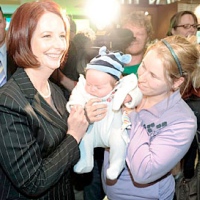 Latham with an axe to grind, a microphone and a camera crew in tow. Throughout the campaign Latham would rear his clown-like face again and again, in a ghostly and chilling, yet highly entertaining reminder of opposition leaders past.
Latham with an axe to grind, a microphone and a camera crew in tow. Throughout the campaign Latham would rear his clown-like face again and again, in a ghostly and chilling, yet highly entertaining reminder of opposition leaders past.
Leaking like a sieve
Shortly after, the damaging leaks against Gillard began circulating.
The leaks initially related to a supposed deal between Gillard and Rudd to allow the former PM more time to revive his leadership, that Gillard then broke on the night of the Gillard coup. The next round of leaks included claims that Gillard as Deputy PM had argued in Cabinet against paid parental leave and questioned the size of a pension rise, saying it was too large and that “elderly people don’t vote Labor anyway”. A very bad look indeed. Laurie Oakes, the recipient of the leaked information, identified the source as Labor. Rudd and Lindsay Tanner, both with reasons to be aggrieved by Gillard, were the obvious candidates; however both denied being the source of the leaks.
The campaign proper
After all of that, the election campaign itself proved to be rather lifeless from start to end. An early indication was arguably the most boring election debate in Australia’s recent history with post-debate discussion largely concentrated on the size of Gillard’s earlobes. Admittedly, they did look rather huge…. This was surprising given the perennial niggling between Gillard and Abbott which had provided some of the more entertaining moments in Parliament and on tabloid television throughout 2009.
The important point being, that stripped of their attack-dog Parliamentary duties, neither of the two leaders yet has a meaningful policy narrative or a driving mandate for leadership.
Once censored by leadership responsibilities, just another politician struggling for a narrative.
Accordingly, during the campaign the media were captivated by the side bars if for no other reason than they contained more page turning fodder than the election campaign itself. However, at times these stories veered from boring to weird to bizarre, and Mark Latham was omnipresent, terrorising all sides of politics with his impromptu appearances on the street, RSLs, shopping centres – enough to ruin a photo opp and a politician’s day.
Abbott’s own performance and campaign was at times disastrous, but he was generally positioned in the right place at the right time, able to be a small target when necessary and be larger than life when required. Many Australians are personally offended by Tony Abbott’s manner and his views. His fundamental beliefs were formed from deep within the nest of a far right religious-inspired politic that lost its relevance two decades ago. However, Australians were also disappointed by a first term Labor Government that under-delivered in some key areas, was unable to remain stable during its term and failed to communicate its successes when it had them. By the time the election came round it had even lost the only thing that could automatically save it: incumbency.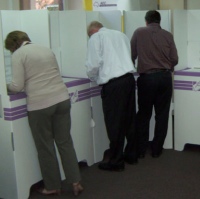
Abbott’s skills were to evoke the right sorts of emotions to voters when it was needed. While the Labor Party was in raptures, Abbott made use of something people now associate with stability: the Howard: Costello years. Abbott essentially claimed to be channelling Howard: Costello during his official campaign launch, and there were John and Jeanette Howard front and centre on the night. There was a growing sentiment among many of the Liberal voters snatched by Labor in the 2007 election that they regretted voting out Howard. This sentiment was gauged and then tapped into. Abbott’s small target approach was vindicated on Election Day by virtue of the damages inflicted on Labor, but it was not enough to outright win the election.
Abbott’s sudden sense of control and calmness in the campaign proper was the sign of a focussed re-invention attempt at bringing out the Howard within and shaking off the “mad monk” status, albeit with measured success. Some of the times that he did stick his head up, he put his foot in it. Amongst the most notable stuff ups was his routing by Kerry O’Brien on the 7:30 report in June 2010, effectively admitting to being a liar. What seemed political suicide at the time was soon forgotten in and amongst the dramas that befell the Labor Party.
Energetic appearances by Rudd in the last few weeks of the campaign were actually pretty heartfelt, there’s plenty in it for Rudd – possibly a plum portfolio (Foreign Affairs or Defence) and if there’s anyone Rudd hates more than Gillard it is Abbott (or Turnbull). Nevertheless, kudos to Rudd for restraining himself from ending up like the bitter and twisted Latham despite moments of Lathamism earlier in the year when the former Prime Minister responded to Kerry O’Brien’s question with “Let me tell you mate…” on the 7:30 report in May 2010.
Tony Abbott’s last 36 hours leading to the election were his best. He was frantically traversing the country, getting in front of as many cameras as possible and looking Prime Ministerial. He knew it would be close and was campaigning vigorously to the end. Abbott cleverly tapped into the sentimental reminiscences of the Howard-Costello days when life was easy. A vote for Abbott we were told, was also a vote for the Howard-Costello legacy, as if on election night they’d all be wheeled out as old friends to the tunes of an old Hoodoo Gurus track (all the good times we had we’ll have again). They knew it was going to be close, so any campaigning could prove to be decisive.
The election result
The Hung Parliament
Not surprisingly, voters flocked to anyone who stood for something or who was on message, namely the Greens and Independents. With a hung Parliament, Australia has gone the same way as Great Britain, and as the US may follow.
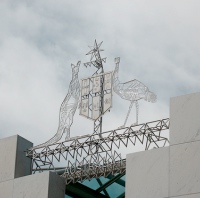 Neither party was able to win the 76 seats required to rule in their own right. With about 80% of the votes counted, the major parties are sitting on 71 seats each, the Greens secured one seat, and four seats were secured by Indpendents. This leaves three seats where the result is still too close to call, namely Brisbane, Corangamite and Hasluck.
Neither party was able to win the 76 seats required to rule in their own right. With about 80% of the votes counted, the major parties are sitting on 71 seats each, the Greens secured one seat, and four seats were secured by Indpendents. This leaves three seats where the result is still too close to call, namely Brisbane, Corangamite and Hasluck.
With neither party able to secure the majority of seats, a hung parliament is in order meaning that no laws can be passed without gaining the support of the other parties and the Independents. Either a formal coalition is in order or the governing party would need to negotiate with the other parties to get laws passed.
The five minorities comprising the Greens member and the four Independents will determine the next leadership of Australia as a result of the hung parliament. The four independents, Tony Windsor, Rob Oakeshoft, Bob Katter, and Andrew Wilkie are the new kingmakers, thrust centre stage in the unfolding political tragedy, and they will decide the fate of the leadership.
This is the same sort of political feeling sweeping many western countries, with voters having embraced left-leaning social democratic governments enthusiastically but now in two minds about whether to go back to the right side of politics.
Swings and roundabouts
Voters roundly turned on the first term Labor Government and Gillard, its Prime Minister of two months. Labor has suffered a 5.4% swing against it. However after about 80% of the vote counted the Labor party leads the two party preferred position at 50.6%.
The greatest damage to the Labor party was done in Western Sydney and in Queensland, the latter being the Rudd heartland from the 2007 election. Labour suffered a swing of over 6 per cent in New South Wales (NSW) and 9% in Queensland.
Labor lost 12 of its seats, including the traditional Liberal seat of Bennelong bringing an end to former journalist Maxine McKew’s short political career. Bennelong, sensationally won by McKew at the expense of John Howard in 2007, was once again returned to its home as former tennis ace John Alexander took out a straight sets victory over McKew with a 5% swing against Labor.
Maxine was not happy, Julia. McKew blamed the swing on the recent change of Labor leadership and not enough campaign focus on Labor’s role in Australia’s recovery from the Global Financial Crisis. Both of McKew’s claims are subject to scrutiny.
All but one of the seven seats visited by Rudd during the campaign was lost by Labor, some referring to this as ‘Kevin’s Curse’. Of course causation is difficult to prove. Rudd’s own seat of Griffith did see a 9% swing against the Labor party, however. The BER, widely acknowledged to have been botched but largely forgiven because people believed it had saved from recession, has received fresh scrutiny from a BER taskforce review. It showed that the majority of the spending undertaken (a fraction of the actual funding allocated), took place after the economy had recovered from the initial, harrowing days.
Other traditional safe Liberal held seats such as Western Suburbs Lindsay also swung heavily against Labor.
The events described above showed up explicitly in the results. The RSPT showed itself in Coalition popularity in WA and Queensland, the ETS ditching manifested in a stronger Green vote. The dumping of Rudd led to a voter protest against Labor in Queensland. The small target campaign of negativity executed by Abbott caused damage but was not enough for a decisive election win. The calculated gambles and perception corrections of the Labor Party under both Gillard and Rudd did not convince the Australian people – not easily outfoxed.
Campaigns based on damaging your opponent or based on perceptions management will only get you so far, was the message to the party leaders.
An election of firsts
This election marks a number of first time events, as did the past election. Election 2007 marked the first rock star in the lower house as well as the first TV personality, the first time a 12 year serving Prime Minister was ousted from their seat and the first time that a candidate campaigned on Rove Live.
The firsts in this election include the first 20 year old (Wyatt Roy) admitted to Parliament, the first Greens member in the House of Representatives, possibly the first Indigenous Australian in the House of Representatives (Ken Wyatt) and possibly the first elected female Prime Minister of Australia – or otherwise the first single term government to lose office since the Scullin Government in the early 1930’s. It too suffered a global financial crisis in its case, the 1929 Great Depression, shortly after winning a landslide victory in which the sitting prime minister lost his seat.
The firsts of elections past and present may be an indication of an Australia changing with the times.
Certainly the increasing diversity of candidates and elected members is refreshing particularly in the case of increased Indigenous representation in Parliament. On the other hand, some firsts, such as electing a rock star without any qualification for the job, and a 20 year old with no background in politics or anything else for that matter seeing as he was born in 1990 may just be a sign of a nation that’s given up on expecting anything from its politicians.
Policy?
Policy seemed to be absent for a lot of the campaign. One of the clearer divides to emerge between the two parties is their approach to the NBN. The coalition has pledged to scrap the $43 billion NBN and leave the fate of our future connectivity in the hands of Telstra.
The coalition policy platform, as outlined in the party’s “Action Contract” is based on a tougher stance on asylum seekers (“stop the boats”), reducing Government debt and dismantling Labor initiatives such as the National Broadband Network.
It was an indictment on the campaign that the messages that seemed to cut through the most were the respective policies on national broadband. This is because the policy was easy to communicate, it was relevant and both parties had clearly defined and highly contrasting policies.
Not gone….not forgotten
I wasn’t the only one to notice that Malcolm Turnbull was the first and most aggressive signposter in the 2010 campaigning. There were so many of those brightly yellow posters up on lampposts about town I started to imagine them everywhere.
Kevin Rudd and Malcolm Turnbull both cruised to victories in their respective electorates. There is no doubt that both expect to have a second chance at leadership of their parties. Both have managed to at least partly behave during the campaign and this would have put them in good stead. The historical precedents are there for dumped leaders to return to power.
What can we expect going forward?
We’re faced with a period of instability, first until the election result is settled, and then further instability because the Government will be a patchwork quilt over strange bedfellows – either a ‘Coalition-coalition’ Liberal-National-Independent or another coalition of sorts between Labor-Independent-Green.
Each of the major leaders will be trying to cut a deal with as many Independents as possible. The lobbying, rallying, courting, will be furious and intense. While the Kingmakers have all signalled their intention to form a ‘bloc’ of sorts, it is inevitable there will be divisions even within this new unit.
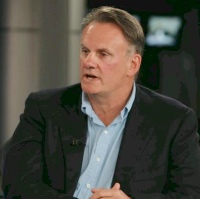 Parliamentary reform has become a central point of negotiations, with peachy suggestions such as cross party cabinets, suggesting Rudd for Foregin Minister for Coalition as an example, thrown into the mix by Independent MP Oakeshott. While things don’t have to get so out of hand, election 2010 results alongside global trends have made it clear that citizens expect a change in the way that Government operates. A minority government may be exactly what is required to make the transformation from cowboy politics to an effective policy decision making machine – namely Consensus Parliament. But there are many caveats. The ability for the parties to reach consensus as driven by the ability to negotiate and make compromises, independence of the Independents and the willingness and ability for politicians to harness change. History suggests that these are likely to be too big an ask. However, it could always be worseiv.
Parliamentary reform has become a central point of negotiations, with peachy suggestions such as cross party cabinets, suggesting Rudd for Foregin Minister for Coalition as an example, thrown into the mix by Independent MP Oakeshott. While things don’t have to get so out of hand, election 2010 results alongside global trends have made it clear that citizens expect a change in the way that Government operates. A minority government may be exactly what is required to make the transformation from cowboy politics to an effective policy decision making machine – namely Consensus Parliament. But there are many caveats. The ability for the parties to reach consensus as driven by the ability to negotiate and make compromises, independence of the Independents and the willingness and ability for politicians to harness change. History suggests that these are likely to be too big an ask. However, it could always be worseiv.
To be continued…Part 2 of this story will be released post the final election results
Cameron O’Neill and Nazia Ahmed work in Finance and Economics
i See The Cud July 2009 “Looking back on the month of June in the Australian Parliament”)
ii Ibid.
iii See The Cud December 2009: “Copenhagen: Expectations, politics and science collide in the Danish capital”
